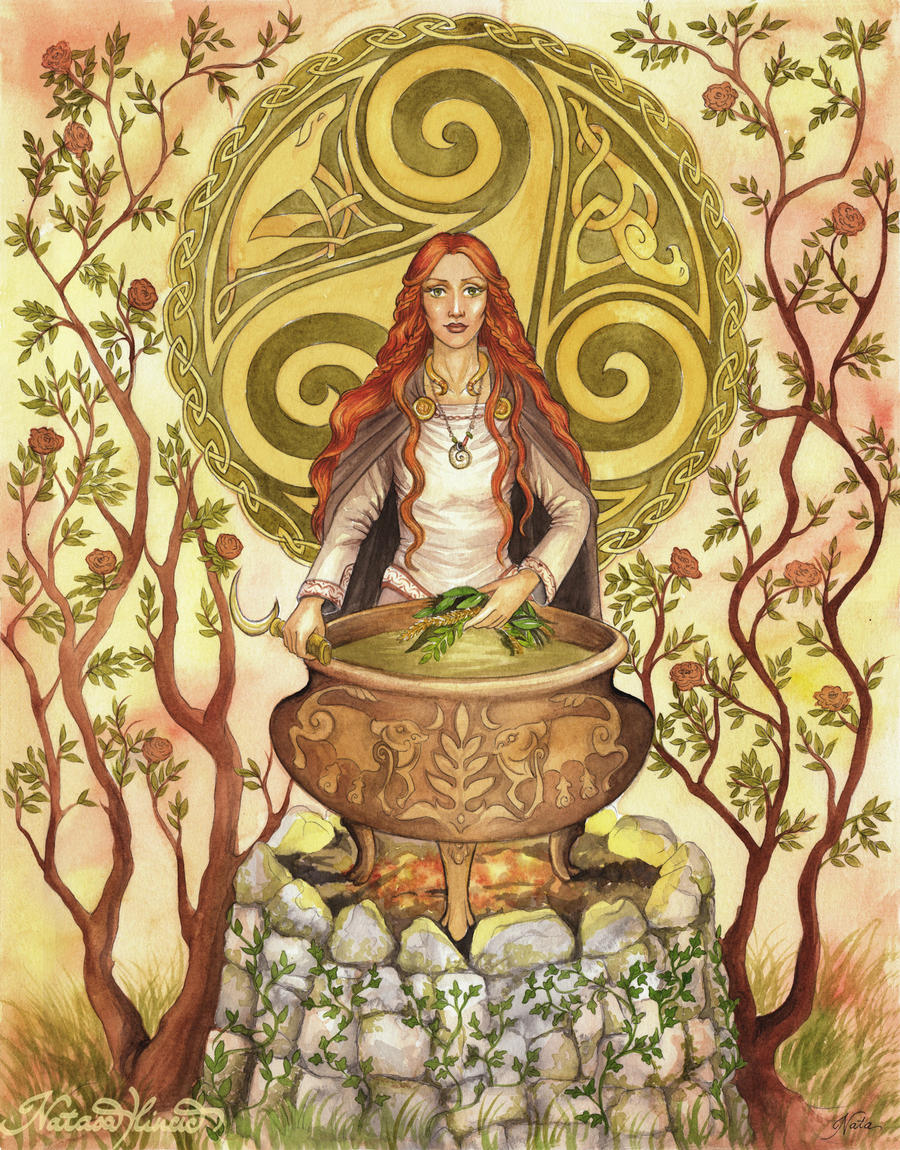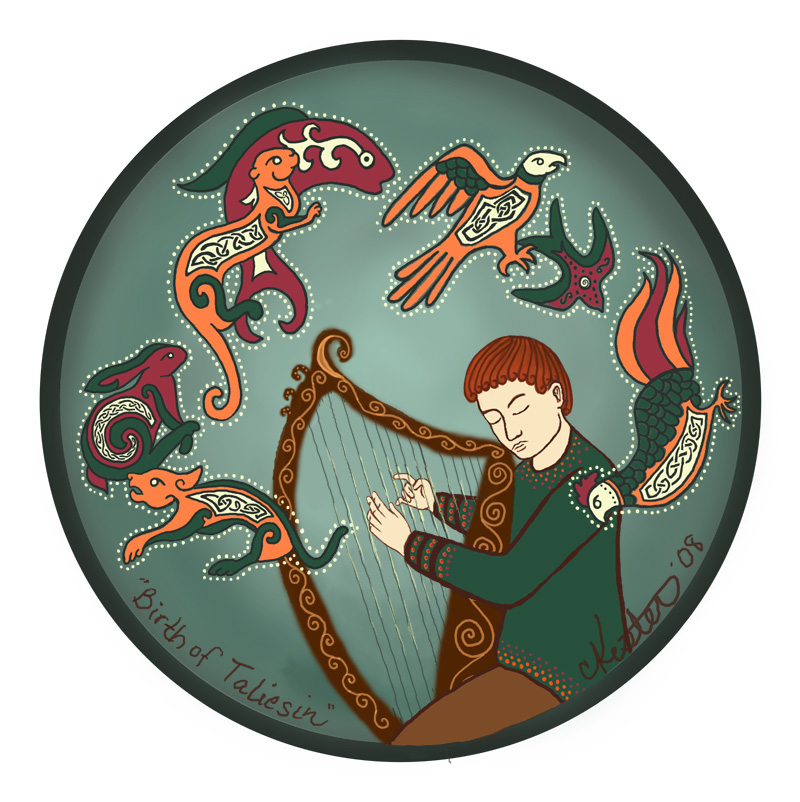Según la leyenda, Ceridwen era madre de tres hijos: Crearwy, quien era la joven más hermosa del mundo; Morvan que era un hombre feo, pero fuerte y valiente en la batalla y Afagduu que era tan terriblemente feo que no sería aceptado jamás por la sociedad. Cerridwen decidió compensar la fealdad de su hijo volviéndolo el más grande de los bardos galeses, para lo cual prepararía una poción, de la cual solo las tres primeras gotas serían mágicas, siendo el resto un letal veneno.
La poción hecha con seis hierbas mágicas debía cocinarse durante un año y un día; para vigilar la poción, Ceridwen tenía dos sirvientes, el anciano y ciego Morda y el joven Gwion (o Gwyon) a los cuales había advertido que no tocaran ni una gota de la poción, so pena de sufrir una muerte terrible.
Pero un día que Gwion se encontraba removiendo la poción, tres gotas del líquido ardiente saltaron sobre su mano, instintivamente, Gwion se llevó la mano a la boca, obteniendo así los dones que estaban destinados a Afagduu.
Furiosa, Cerridwen persiguó a Gwion para matarlo, pero el joven, utilizando sus nuevos poderes mágicos, se convirtió en liebre. Cerridwen, entonces, se convirtió en perro; Gwion se transformó entonces en pez y saltó a un río, Cerridwen se volvió nutria y continuó la persecución; Gwion se convirtió en gorrión y Cerridwen en águila. Finalmente, el joven se transformó en un grano de trigo y Cerridwen, en forma de gallina, se lo comió.
Cuando Cerridwen volvió a su forma humana, se dio cuenta de que estaba embarazada y que el niño que llevaba en su vientre era Gwion y resolvió matarlo en cuanto naciera.
Sin embargo, cuando el bebé nació, era tan hermoso que Cerridwen no se atrevió a matarlo, así que metió al bebé en un saco de piel de foca y lo tiró al mar. Sin embargo, el niño sobrevivió y fue recogido en la costa por un príncipe llamado Elphin, el cual adoptó al bebé, llamándolo Taliesin. Con el paso del tiempo, Taliesin marchó a la corte del Rey Arturo, donde se convirtió en el arpista principal y en consejero del rey.
Damh The Bard - Ceridwen and Taliesin
Silver moonlight dances,
From the mist of Tegid's shore,
A lady looks upon her son,
Like many times before,
A she touches his face,
Fingers wet with the tears falling.
Her daughter stands beside her,
The fairest in the land,
How her son became so cursed,
She cannot understand.
But this mother's love is a strong,
As her heart is beating,
And she calls to the Earth,
And the Earth hears her calling.
High up in the mountains,
Dinas Afferaon stands tall,
All magic and all mysteries,
Are held within these walls,
So she walks to the door,
As she does the door it opens,
Teach to me the mystery,
Of the Cauldron's Brew,
Let Utter Darkness give way to light,
And be reborn anew,
Then the Awen will shine,
From the brow of the Eagle of the Sea,
And all will know his name,
From this land to the People of the Sidhe.
The lady sets the cauldron's fire,
Tended by the hand,
Of Gwion Bach the innocent,
And Morda the blind man,
Who reached out his hand,
Place more wood,
Keep the cauldron boiling.
Then Morda he fell asleep,
Alas he din't see,
Wood upon wood was added,
The inferno was the key,
To unlock the doors,
Of the Awen's greatest mystery,
Three drops, burning skin,
And it's Gwion how gained the power to see.
The cauldron cracks, the poison seeps,
Slowly across the land,
To kill the horses of Garanhir,
by the lakeshore where they stand,
Drinking and not knowing their fate,
As a hare runs fast across the land.
Ceridwen, Ceridwen,
Lady of the Cauldron,
Come see what they have done!
Stolen your Cauldron's power,
And betrayed your only son!
Eyes wide, lips curl,
Anger on your face!
Change your shape now lady!
Be the hound, begin the chase!
I shall be a running hair,
With sorrow and with mickle care,
Then I shall be a greyhound bitch,
And tear you from your skin!
Then I shall be a flying wren,
The King of Birds, the King of Men,
Then I shall be a falcon grey,
And tear you from your skin!
Then I shall be a salmon sleek,
Darting through a shallow creek,
Then I shall be an otter bitch,
And rest you from your skin!
I shall be a grain beneath the sun,
And you will never know which one,
Then I shall be a great black hen,
And take you deep within!
Now you may be forgiven to think,
My tale is over and down,
But nine moons later,
She gave birth to a son,
That she wanted to kill,
But she placed in a coracle on the sea.
Garanhir's salmon weir,
A catch was guaranteed,
But on this day a baby boy,
Cried out to be freed,
A radiant brow,
Shining bright for all to plainly see.
Taliesin is your name,
The greatest Bard that this land will ever see!



































